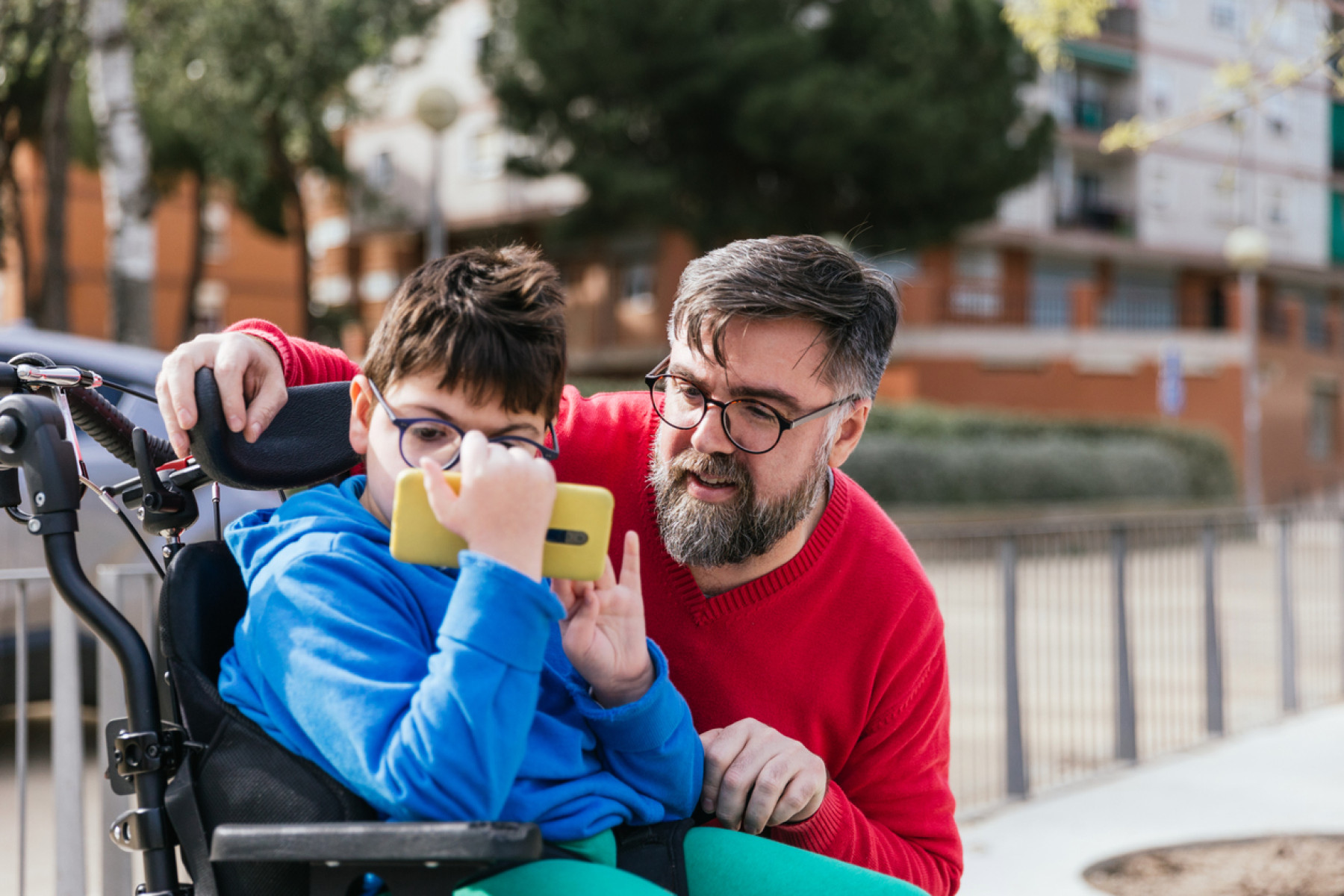
For most people these days, being able to use a smartphone has become an essential part of modern life. Communicating with friends and family, booking appointments, managing public transport and a range of other activities are almost impossible without being able to use smartphone technology. For many of us, it's hard to imagine what life would be like without these devices.
And while smartphones have made a range of tasks easier for many people, they can unfortunately pose huge challenges for people with cognitive disabilities and other forms of disability.
That's why we were excited to hear that Apple has recently released new accessibility features on its iPhone or iPad, known as Assistive Access. These features make it easier for people with cognitive disabilities to use these devices.
In this blog, we wanted to run you through the basics of Assistive Access on iPhone so you can work out if it's something that might help you or your loved one operate their smart phone more easily.
What is iPhone Assistive Access?
Assistive Access is a feature on iOS and iPadOS that simplifies the user interface and enhances accessibility features for people with cognitive disabilities. It revamps the Home Screen and the basic apps on iPhone or iPad and provides a distinct interface with high-contrast buttons and large text labels as well as providing a range of other accessibility features.
How to Activate Assistive Access for People with Cognitive Disabilities
To enable Assistive Access, you need to configure settings:
Open the Settings app on the iPhone.
Scroll down and select Accessibility.
Tap on Assistive Access.
Tap on Set Up Assistive Access.
Follow the on-screen instructions to complete the setup process.
More detailed instructions on entering assistive access can be found on the Apple website.
It's important to note that in order to enter assistive access, you need to have iOS17 installed on your device. Only iPhone models from 2018 onwards can install iOS17. This includes all models from the iPhone XS and iPhone 11 on.
5 New Assistive Access Features for People with Disabilities

There are a number of reasons we're so excited about Assistive Access on the iPhone and iPad and we wanted to share a couple of them with you. While the ability to automatically pause images, on-device machine learning, voice control guide, voice commands, single calls app, and the emoji only keyboard may be of benefit to many, we wanted to compile our list of the top 6 Accessibility features on the iPhone:
Simplified App Layout
The Assistive Access Simplified Layout provides a custom, simplified experience for the iPhone home screen, FaceTime, Messages, Camera, Photos, and Music apps. Unnecessary apps are removed from the assistive access home screen and the remaining apps are made bigger. In this way, distractions are minimised to reduce cognitive load and operating the screen becomes a more straightforward task.
There are also options for high contrast buttons and large text labels. You can also choose between a row based layout or grid layout for the screen, depending on your preference.
There are also shortcuts to allow you to switch control out of a row based layout and back to the original layout.
Simplified Camera App
For many years, iPhones have boasted fantastic cameras. However, for some, they have always been a challenge to use. Assistive Access makes process of taking a photo a lot simpler.
When Assistive Access is turned on, the camera is simplified. The new layout has four big options only. One for Photo, Video, Video Selfie, and Selfie along with a simple Shutter button. This is a great example of one of Apple's optimised apps for accessibility.
Simplified Apple Music App
While it may not be everyone's favourite music app, the new accessibility features of the Apple Music app may go a long way towards changing people's minds.
When Assistive Access is turned on, the Apple Music app layout is transformed to further reduce cognitive load. It is simplified so that it has a large album cover tile and large Back, Play, and Pause buttons.
Automatically pause images
This is a feature that allows you to stop the motion in content like animated images on web pages in Safari, or GIFs shared in a Messages group chat. This can be helpful if you are sensitive to rapid animations or want to reduce distractions to minimise the cognitive load animations can create.
Live Speech Helps You Communicate
Strictly speaking, Live Speech is not a part of Assistive Access, but it is a fantastic new accessibility feature on the iPhone that allows users who are nonspeaking or at risk of losing their ability to speak to type what they want to say and have it spoken out loud in calls and conversations.
To use Live Speech, you need to turn it on in the Settings app under Accessibility. Then you can triple-click the side button to open the Live Speech keyboard and enter the text that you want spoken aloud. Text prompts and text editing help to speed up the process. You can also choose from dozens of system voices or create a personal voice that sounds like you. For once, siri voices sound natural!
Live Speech works with FaceTime and phone calls, as well as supported assistive communication mac apps. For those who prefer text, You can also use it for in-person conversations by playing the voice from your device’s speakers. This is a great way to make use of the personal voice feature as well.
Detection Mode will Soon Read Labels For You
While Detection Mode already exists on the iPhone, Apple has indicated that it will soon be able to read text on things like labels and convert them to voice.
The original detection mode uses LiDAR (a form of radar using laser), to help you identify people, doors, and physical objects in your surroundings. It is part of the Magnifier tool and can provide feedback through sound, speech, haptics, and visuals, depending on your preferences. You can also use detection mode to get image descriptions.
To enable detection mode for things like door detection, you need to have an iPhone 12 Pro or later model, and you need to turn on Magnifier in your settings. You can also access it through the magnifier app.
A Step in the Right Direction for Accessibility Features
Assistive Access on the iPhone provides a more tailored and simplified user interface for people with cognitive disabilities, such as autism, dementia, or Down syndrome and those hard of hearing users. It allows users to choose the layout for apps onscreen and emphasises images over text.
The new features also let users customise the apps they want to use in Assistive Access, and some apps have been optimised for this mode, such as Calls, Camera, Messages, Music, and Photos. Personal voice and live speech are also fantastic additions. Apple has also made compatibility with hearing devices a focus of the iPhone. Hearing devices directly connect seamlessly through Bluetooth pairing.
By offering a more focused and personalised experience, Assistive Access can help users enjoy the benefits of iPhone with greater independence and confidence.
How Focus Care Can Help
Assistive Technology can offer valuable assistance to enhance the independence and well-being of people with cognitive disabilities. However, living with a cognitive disability, or supporting someone with one, can still have its challenges. It's important to remember that you are not alone. There are resources and professionals available to guide you through this journey.
At Focus Care, we provide leading home care services for everyone, including people with an cognitive disabilities. Our disability support services page will tell you our current offerings - you might even like to try creative support solutions like art therapy!
We treat clients as individuals and our goal is to provide a personalised level of care and support. Talking together, we can work with you to find the care solutions you need - and the flexibility and freedom you want.
Do you want to find out more about the cognitive disability support services we offer? Reach out to our fantastic team or read through our list of services.




